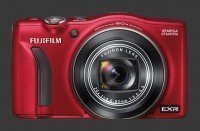Fujifilm Finepix F770 EXR Review
Fujifilm Finepix F770 EXR Performance - How well does it take pictures?

The EXR technology used by the Fuji Finepix F770 EXR is very capable, with each mode delivering outstanding results in some way. While the baseline HR results of the F300 where excellent and the SN and DR modes enhanced things further, the new EXR BSI-CMOS sensor used in the F770 EXR produces results which are nice but not class-leading in HR mode. In SN mode things are much improved and in DR mode as well, only differently.
Starting with Resolution Priority (HR) mode, image noise is minimal at ISO 100 but shows up clearly at 400. It slowly increased until ISO 1600 where results remain just usable for mid-sized prints. ISO 3200 shows considerably more softness and settings beyond that are of limited use. In Low-Noise Priority (SN) mode, images show very little noise until ISO 800 while remaining quite sharp. ISO 1600 shows a bit of softness but remains very usable for most common print sizes. In Dynamic Range Priority (DR) mode, noise levels are somewhere in between but closer to SN mode. There, noise-levels increase steadily but without much softness even until ISO 3200, the maximum allowable sensitivity. Certainly, ISO 100 to 400 settings are completely usable for mid-to-large prints in DR mode.
The F770 EXR has six settings for dynamic-range: 100%, 200%, 400%, 800%, 1600% and Auto. Auto simply chooses among the other four settings depending on the current ISO sensitivity and several metering points. This means that Auto ISO cannot obviously choose a DR setting which is not available at the set ISO and that it can choose the wrong setting if the metering points do not detect the scene's entire dynamic-range. This may happen for example if there are very bright spots near the edges of the frame. The 800% and 1600% settings are only available for images shot in EXR-DR mode and are limited to 8 megapixels.
Expanded dynamic-range is extremely useful for outdoor photography where the sky easily gets over-exposed in order to main subject-details. Anyone who has been on a general-interest tour probably suffered from visiting places when the light was too contrasty to obtain nice results. There are travel photography tours which plan for this and bring visitors to the right places at the ideal time of day.

Optical distortion is nearly invisible. This is very impressive as only a slight amount of barrel distortion can be seen at the widest setting. Equally impressive is that no vignetting can be seen throughout the entire optical zoom range. Amazingly, we did not find any chromatic aberrations with this lens either. Fuji managed to further improve upon its previous Travel-Zoom lens and solve the edge softness problem. Indeed, the Fuji Finepix F770 EXR produces images with consistent edge-to-edge sharpness.
Color on the Fuji Finepix F770 EXR is controlled by Film-Simulation: Provia, Velvia, Astia, B&W or Sepia. Provia is the default setting with natural but gently oversaturated colors. The Velvia setting boosts saturation across all colors giving a more punchy rendering without being over-the-top. Astia is the softest setting with some slight oversaturation compared to reality, it does show more gentle contrast though. The automatic white-balance system of the F770 EXR is excellent, rarely leaving a color-cast. It even handles artificial lighting surprisingly well. Custom white-balance is quite close to perfect. The difference can be measured but it rather hard to see.
The metering system is good and manages to balance shadows and highlights very well. This is certainly helped by this camera's exceptional dynamic range. In high-dynamic range mode, it is surprisingly difficult to make it burn-out highlights. This is the most impressive and advantageous of all EXR modes. One thing that users will need to know is that the dynamic range captured by the Fuji F770 EXR is still greater than what can be shown on the camera's LCD screen. This means it is possible that highlights look blown-out in the preview.
The F770 EXR does everything fast. Startup is quick and so are focusing and zooming. While not having the F300 EXR's ultra-fast phase-detection autofocus, the F770 EXR is one of the fastest focusing compact cameras to date. It locks focus quickly, down to relatively low light levels. The all-important shutter-lag is nearly instant. Shot-to-shot speeds are very good, taking just over 1s. In Playback mode, everything is quite fast, even zooming into images. This digital camera has image stabilization which proved extremely effective at all focal lengths. At both ends of the zoom, there is roughly a 3-stop advantage over the usual hand-held rule-of-thumb.

The CMOS sensor allows high-performance burst modes. The Fuji Finepix F770 EXR can shoot at 3, 5, 8 or 11 FPS. It can also sustain this for 8 RAW or 16 JPEG images. Here this camera shows some bizarre feature interaction:
- RAW capture is limited to 5 FPS or slower.
- 16 MP JPEG capture is limited to 8 FPS
- 8 MP JPEG capture can go up to 11 FPS
- Dynamic range is limited to 100% at 8 FPS or higher
Unlike previous models, continuous shooting starts immediately but the display still gets choppy. This makes following action on the difficult side. In Playback mode, Fuji groups bursts of continuously shot images. They can be seen as a short looping animation and deleted as a whole or one can enter into the burst to play and delete individual images.
With a battery-life of 300 shots per charge, the Fuji F770 EXR gives in an average performance for a modern compact digital camera. Using the GPS adds extra stress on the battery because it works between shots and, optionally, while the camera is powered off. This means you have to keep shooting to get those 300 shots per charge, otherwise the GPS will drain the battery. The Auto-EXR mode also seems to eat up an extra percentage of battery power, constantly scanning and focusing.
Fujifilm Finepix F770 EXR Conclusion
The Fuji Finepix F770 EXR pushes the limits of its form-factor by offering a 16 megapixels BSI-CMOS sensor and an ultra-wide 20X optical zoom lens in a 1.4" thick body. This camera packs a very complete feature set including full manual-controls, custom white-balance, spot-metering, bracketing, 1080p HD video with stereo sound, a built-in GPS and RAW capture. No current compact camera has all these, although if you ignore RAW capture a few models make the list.
The F770 EXR turns in a very solid performance. Exposure, color, white-balance and focus are all very accurate and reliable. At its maximum resolution of 16 megapixels, image noise is reasonable without being top-notch. However, its special EXR CMOS sensor lets it capture an incredible dynamic-range or very low-noise images at 8 megapixels. The lens is also exceptionally sharp with little distortion and aberrations for such a compact lens.
This digital camera is quite fast too. Focusing speed is very quick and the camera remains responsive during most operations. The all-important shutter-lag is excellent and so is the shot-to-shot speed. The slow aspect is a troublesome 2s delay in starting to record video. Ergonomics are generally good but usability is rather quirky when it comes to using manual controls.
Compared to its predecessor, the Fuji F770 EXR improves image quality with lower noise and adds consistent sharpness throughout the frame. The body design is refined and handles more easily with a smooth luxurious finish. It adds a mechanical flash release which fixed the constantly popping flash of previous models. Overall, this digital camera proves itself to be a very good and extremely capable travel zoom.
 |
Please Support Neocamera
All information on Neocamera is provided free of charge yet running this website is a huge endeavor. Purchases made via affiliate links found throughout the site help keep it running and up-to-date. There is no additional cost to you, so please consider buying via these links to our affilates:
If you found any information on this site valuable and did not purchase via our affiliate links, please considering donating via PayPal:
Any amount will be greatly appreaciated. Thank you for your support!
Fujifilm F770 EXR Highlights

Sensor-Size: 6 x 5mm

Actual size when viewed at 100 DPI
| 16 Megapixels Travel Zoom | ISO 100-3200 |
| 20X Ultra-Wide Optical Zoom | Shutter 1/2000-8s |
| Built-in Stabilization | Full manual controls |
| 1920x1080 @ 30 FPS Video Recording | Custom white-balance |
| 3" LCD 460K Pixels | Spot-Metering |
| Lithium-Ion Battery | |
| Secure Digital Extended Capacity, Internal Memory |
Updates
2024.11.18

Best 2024 Photography Gifts for Every Budget
Great gifts for photographers and photo enthusiasts selected for every budget among the best products of 2024.
2024.08.07

Eye Protection Tips for Professional Photographers
The four main considerations for professional photographers regarding eyewear.
2024.07.14

Fujifilm X100VI Review
Flagship fixed-lens compact digital camera with a 40 MP sensor and Image-Stabilization, a first for the series. Retro design featuring dual control-dials, plus direct ISO, Shutter-Speed and EC dials. Its hybrid viewfinder can switch between EVF and OVF mode.
2024.05.09

Fujifilm GFX100 II Review
Flagship 102 Megapixels Medium-Format Mirrorless Digital Camera with 8-Stop 5-Axis IBIS, 8 FPS Drive, 8K Video and 400 MP Super-Resolution capture in a weatherproof and freezeproof body with dual control-dials and dual memory-card slots.
2024.04.03

Fujifilm X-T5 Review
Newest Fujifilm flagship boasting a 40 MP APS-C sensor, 5-axis IBIS with 7-stop efficiency, 15 FPS continuous drive, 6.2K Video capture, dual control-dials and dual SDXC UHS-II slots in a sturdy weatherproof and freezeproof body.
2023.11.20

Best Digital Cameras of 2023
Find out which are the Best Digital Cameras of 2023. All the new Mirrorless Digital Cameras from entry-level to high-end professional.
2023.07.10

Fujifilm X-H2 Review
40 Megapixels APS-C Hybrid Mirrorless Digital Camera with 7-stop IBIS. Fastest shutter ever and 8K video capture. Large builtin EVF with 0.8X magnification and 5.8 MP, plus an Eye-Start Sensor. Packed with features and large number of controls in a weatherproof and freezeproof body.
2023.05.07

Sony FE 20-70mm F/4G Review
Review of the unique Sony FE 20-70mm F/4G lens. The optical zoom of this lens spans ultra-wide-angle and medium focal-length coverage, making it one of the most versatile Full-Frame lenses on the market.
2023.01.15

Huion Inspiroy Dial 2 Review
Review of the Huion Inspiroy Dial 2 tablet, a medium sized drawing surface with dual dials and customizable buttons. Connects via USB-C or Bluetooth 5.0 with Windows, Linux and Android support.
2022.12.08

How to Pack for a Photo Trip
Find out how to pack for a travel photography trip, carry your gear safely while meeting airline regulations.
2022.11.13

Best Digital Cameras of 2022
The best digital cameras of 2022. A short list of the most outstanding models in their respective categories. Choose one for yourself or as a gift.
2022.09.21

Pentax DA* 60-250mm F/4 SDM Review
Review of the Pentax DA* 60-250mm F/4 SDM, the constant-aperture telephoto zoom with the highest zoom-ratio on the market.











